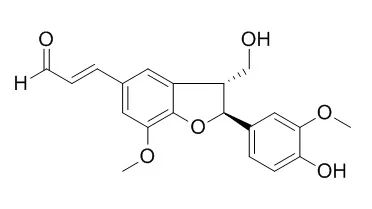| Structure Identification: |
| Journal of Wood Science, 2008, 54(6):483-489. | | Chemical constituents from Gmelina arborea bark and their antioxidant activity.[Reference: WebLink] | Gmelina arborea Roxb. is a fast-growing species and is known to have been used in traditional Indian medicine. Chemical constituents from the bark have not been reported, although some chemical constituents from part of this plant (heartwood, leaf, and root) are known.
METHODS AND RESULTS:
In this study, the bark meal was successively extracted with acetone and methanol. Fractionation of the acetone extract with n-hexane, diethyl ether, and ethyl acetate and subsequent chromatographic separation of the fractions led to the isolation of four compounds. The diethyl ether-soluble fraction yielded tyrosol [2-(4-hydroxyphenyl)ethanol] (1); (+)-Balanophonin (2), an 8-5' neolignan, with opposite optical rotation to known (-)-balanophonin; and gmelinol (3), a known lignan. The ethyl acetate-soluble fraction afforded a new phenylethanoid glycoside to the best of our knowledge, which was identified as (-)-p-hydroxyphenylethyl[5'"-O-(3,4-dimethoxycinnamoyl)-β-d-apiofuranosyl(1'" [rightward arrow] 6')]-β-d-glucopyranoside (4). From the methanol extract, two known compounds, 2,6-dimethoxy-p-benzoquinone (5) and 3,4,5-trimethoxyphenol (6), were isolated and identified.
CONCLUSIONS:
The 1,1-diphenyl-2-picrylhydrazyl (DPPH) free radical scavenging assay of the identifi ed compounds indicated that 3,4,5-trimethoxyphenol (6) exhibited moderate activity. |
|






 Cell. 2018 Jan 11;172(1-2):249-261.e12. doi: 10.1016/j.cell.2017.12.019.IF=36.216(2019)
Cell. 2018 Jan 11;172(1-2):249-261.e12. doi: 10.1016/j.cell.2017.12.019.IF=36.216(2019) Cell Metab. 2020 Mar 3;31(3):534-548.e5. doi: 10.1016/j.cmet.2020.01.002.IF=22.415(2019)
Cell Metab. 2020 Mar 3;31(3):534-548.e5. doi: 10.1016/j.cmet.2020.01.002.IF=22.415(2019) Mol Cell. 2017 Nov 16;68(4):673-685.e6. doi: 10.1016/j.molcel.2017.10.022.IF=14.548(2019)
Mol Cell. 2017 Nov 16;68(4):673-685.e6. doi: 10.1016/j.molcel.2017.10.022.IF=14.548(2019)